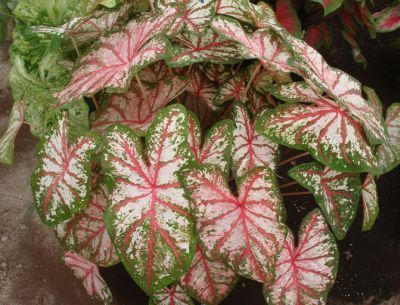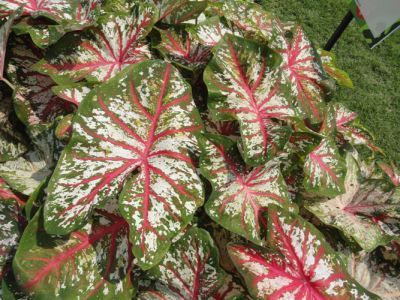Tapestry™ is a fancy-leaved variety with large, attractive pink blotches and red petioles (Figures 1 and 2; Deng et al. 2011). It has demonstrated high tuber yield potential and performed well in forced containers and landscape use. Its performance as a pot or landscape plant was significantly better than 'Carolyn Whorton', 'Fannie Munson', or 'White Queen'. Tapestry™ also sprouts earlier than these existing commercial varieties. These characteristics should benefit consumers and landscapers as well as growers producing tubers and marketing potted or bedding plants.

Credit: Zhanao Deng, UF/IFAS

Credit: Zhanao Deng, UF/IFAS
Origin
Tapestry™ was initially selected in 2004 as GCREC-3141 out of a population of progeny from a cross made in 2003 between 'White Christmas' and 'Red Flash'. Tapestry™ was released as 'UF-172' in October 2010 by the University of Florida Institute of Food and Agricultural Sciences.
Description
Leaves are peltate and cordate with red palmate-pinnate venation. The upper surface has green margins bordering the entire leaf except for the basal leaf valley, which is red. White spots may appear randomly in the marginal area. Numerous white, red, or yellow-green blotches of various sizes, both single and coalesced, appear between the primary veins. The undersurface has a gray-green margin. Primary veins are red, and secondary veins are gray green. A distinct bleeding band of red purple is visible along the major veins. Blotches are variable in color and size. Petioles are mostly erect. Color is gray red with streaks of brown near the apex, and it changes to gray purple with streaks of black near the base. Jumbo-size tubers (2½–3½ inches in diameter) are multi-segmented and bear four to six dominant buds.
Tuber Production
Tapestry™ was evaluated for tuber production at the Gulf Coast Research and Education Center in Wimauma, Florida, in 2006 and 2007. The soil was fine sand with ~1% organic matter and a pH of 6.2. In 2006, raised ground beds (3 feet wide, 8 inches high, and 300 feet long) were fumigated on 30 March with a mixture of 67% methyl bromide and 33% chloropicrin (by volume) at the rate of 175 pounds per acre and covered with white-on-black plastic mulch. Caladium tuber pieces were planted in the beds on 11 April with 6-inch spacing between rows and in rows. A constant water table was maintained below the beds using a seepage irrigation system. Osmocote® (18N-6P2O5-12K2O, 8–9 months) was applied to the bed surface when shoot tips were emerging from the soil at the rate of 300 pounds of nitrogen per acre. In 2007, the beds (28 inches wide, 8 inches high, and 300 feet long) were fumigated on 3 April using the same fumigant mixture that was used the previous year. Caladium seed pieces were planted on 16 April, with 10-inch between-row spacing and 6-inch in-row spacing. A drip irrigation system was used to provide water (~¼ inch per day) and fertilizer (6N-2P2O5-8K2O soluble fertilizer, an average of ~1.7 pounds of nitrogen per acre per day, and a total of 259 pounds per acre per growing season).
Thirty seed tuber pieces were planted in each plot in April 2006 and April 2007, and tubers were harvested in December 2006 and January 2008, respectively. Dried tubers were weighed and counted per plot. They were then graded by maximum diameter: no. 2 (1–1½ inches), no. 1 (1½–2½ inches), jumbo (2½–3½ inches), mammoth (3½–4½ inches), and super mammoth (> 4½ inches). The production index (PI), an indicator of the harvested tubers' economic value, was calculated as: N (no. 2) + 2N (no. 1) + 4N (jumbo) + 6N (mammoth) + 8N (super mammoth), where N = number of tubers in each grade. 'Carolyn Whorton', 'Fannie Munson', and 'White Queen' were included in the field trials as commercial checks. 'Carolyn Whorton' is the most popular and productive variety with pink blotches, somewhat similar to Tapestry™ in leaf coloration pattern. 'Fannie Munson' and 'White Queen' rank third and fourth in acreage among all pink commercial varieties (Deng et al. 2008).
In 2006, Tapestry™ and 'Carolyn Whorton' had similar tuber weights (13.7 pounds and 13.3 pounds), number of marketable tubers (56.5 and 62.1), and PI values (196 and 169) (Table 1). The tuber weights of Tapestry™ and 'Carolyn Whorton' were, respectively, 150%–200% greater than the tuber weights of 'Fannie Munson' and 'White Queen'. The PI values of Tapestry™ and 'Carolyn Whorton' were, respectively, 28%–53% greater than the PIs of 'Fannie Munson' and 'White Queen'. In 2007, the tuber weight of Tapestry™ was 39% greater and the PI 16% greater than corresponding values for 'Carolyn Whorton'. Tapestry™ tended to produce larger tubers than 'Carolyn Whorton' and more tubers in super mammoth (7.0% vs. 2.0%), fewer in no. 2 (18.0% vs. 44.7%) in 2006, and more in mammoth (30.0% vs. 10.0%) and fewer in no. 2 (4.7% vs. 34.0%) in 2007 (Table 1). These results indicate that Tapestry™ is a high-yielding variety.
Container Forcing and Performance
The suitability of Tapestry™ for container forcing was evaluated by forcing tubers in 4½-inch containers and comparing them to forced plants of 'Carolyn Whorton', which has long been valued for its pot performance. Tapestry™ could be marketed in the same leaf color and coloration pattern as 'Carolyn Whorton'. No. 1 tubers were planted either intact or de-eyed in a peat/vermiculite mix (2 sphagnum peat moss, 1 vermiculite, and 1 perlite by volume, VerGro Container Mix A, Verlite, Tampa, FL) on 26 March 2007. The study was conducted in a greenhouse with 45% light exclusion during the summer in Wimauma, Florida. The average daily temperatures ranged from a low of 16°C at night to 29°C during the day over the course of the experiment. Potted plants were arranged on metal benches in the greenhouse in a randomized complete block design with 10 replications. Plant quality was rated on a scale of 1–5, with 1 being very poor and 5 being excellent.
Tapestry™ sprouted 24 days after planting either intact or de-eyed tubers, 5 (intact) or 6 (de-eyed) days earlier than 'Carolyn Whorton', a variety known in the industry for being quick to sprout (Table 2). When intact tubers were planted, Tapestry™ plants were 1.5 inches shorter than 'Carolyn Whorton' plants; when de-eyed tubers were used, Tapestry™ plants were similar to 'Carolyn Whorton' plants in height (~13.4 inches tall). Tapestry™ plants from either intact or de-eyed tubers each produced 23–25 leaves by the eighth week after planting. This was approximately twice the number of leaves produced by 'Carolyn Whorton' plants. With this many leaves, Tapestry™ plants were full and received quality ratings of 3.9–4.4, significantly higher than 'Carolyn Whorton', which received quality ratings of 2.7–3.3.
Landscape Performance
Landscape performance under full-sun conditions was evaluated in 2006 and 2007 on the same plots used for evaluating tuber production. Overall plant performance and sunburn tolerance were both rated on 2 August and 7 September in the 2006 growing season and on 26 July, 28 August, and 25 September in the 2007 growing season. Overall plant performance was rated on a scale of 1–5, with 1 being very poor (few leaves and lack of vigor) and 5 being excellent (full plants, numerous leaves, and bright color display). Leaf sunburn tolerance was rated on a scale of 1–5, with 1 being very susceptible to sunburns and showing numerous sun-damaged areas or holes on leaves and 5 being resistant to sunburns and not showing any sun-damaged areas. Approximately 4 months after planting, plant height, number of leaves, and foliar characteristics were measured.
Tapestry™ was vigorous, ~50% taller than 'Carolyn Whorton', and ~100% taller than 'Fannie Munson' and 'White Queen' (Table 3). Tapestry™ and 'Carolyn Whorton' produced similar numbers of leaves (22.0 and 20.6, respectively), but Tapestry™ leaves were ~1.8 inches longer and ~0.5 inches wider. 'Carolyn Whorton' is considered to be sunburn tolerant (Bates-Cantwell 2001), and it received a rating between 3.6 and 4.2 in 2006 and a rating of 4.3 in 2007 (Table 3). In both 2006 and 2007, Tapestry™ received similarly high ratings (3.9–4.2) as 'Carolyn Whorton', indicating a high level of sunburn tolerance. With the ability to produce numerous leaves that are sunburn tolerant, Tapestry™ performed very well in both growing seasons, receiving performance ratings of 4.4–4.6 in 2006 and 4.8–5.0 in 2007—significantly higher than the scores of 'Carolyn Whorton' (2.2–3.2 in 2006 and 3.7–4.5 in 2007).
Recommendation
Tapestry™ is intended for use in large containers and landscapes. It has demonstrated potential to yield well in tuber production and to perform well in container forcing and landscape use. Its performance as a pot or landscape plant was significantly better than 'Carolyn Whorton', currently the most popular fancy-leaved pink variety on the market. Tapestry™ has the potential to produce prefinished or finished pot plants several days to 1 week earlier than 'Carolyn Whorton'. In pot caladium plant production, tuber de-eyeing is required for production of Tapestry™ in small containers (4–6 inches). In the landscape, Tapestry™ can be planted in sunny or shady locations.
Although extensive research and evaluations of these varieties have been performed on small acreages, tuber producers are encouraged to plant only limited quantities of Tapestry™ until they have gained experience in producing this variety. Standard postharvest treatment of tubers is recommended (Harbaugh and Tjia 1985), and preplant hot water treatment of tubers (Rhodes 1964) is encouraged to prolong the variety's life.
Availability
A plant patent (PP24,432) has been issued for TapestryTM 'UF-172' by the United States Patent and Trademark Office, and production of this variety is to be with a licensing agreement with the Florida Foundation Seed Producers, Inc., PO Box 309, Greenwood, FL 32443. Information on tuber availability and propagation agreements can be obtained from the Florida Foundation Seed Producers, Inc.
Literature Cited
Bates-Cantwell, T. 2001. "The Ins and Outs of Caladiums." GPN – Greenhouse Product News 11:12, 20.
Deng, Z., B. K. Harbaugh, and N. A. Peres. 2011. "'UF-172' a Pink Fancy-Leaved Caladium Cultivar for Large Containers and Landscapes." HortScience 46(1): 132-134.
Deng, Z., B. K. Harbaugh, R. K. Schoellhorn, and R. C. Andrew. 2008. 2003 Survey of the Florida Caladium Tuber Production Industry. ENH1007. Gainesville: University of Florida Institute of Food and Agricultural Sciences. https://edis.ifas.ufl.edu/EP258
Harbaugh, B. K., and B. O. Tjia. 1985. Commercial Forcing of Caladiums. Circular 621. Gainesville: University of Florida Institute of Food and Agricultural Sciences.
Rhodes, H. L. 1964. "Effect of Hot Water Treatment of Seed Tubers and Soil Fumigation for Control of Root Knot on Yield of Caladiums." Plant Disease Reporter 8:568-571.
Tables
Tuber weight, production index, number, and grade distribution of 'Tapestry' and three commercial caladium varieties (2006 and 2007).
Plant performance for caladium varieties grown from no. 1 tubers in 4 ½-inch containers in a 45% shaded glasshouse, 2007, Wimauma, FL.